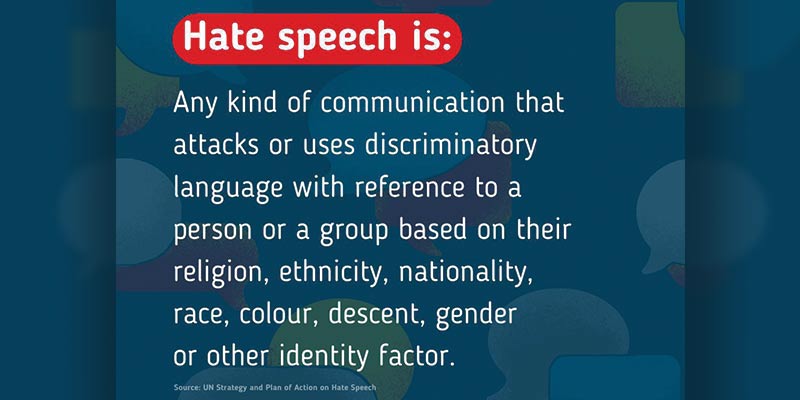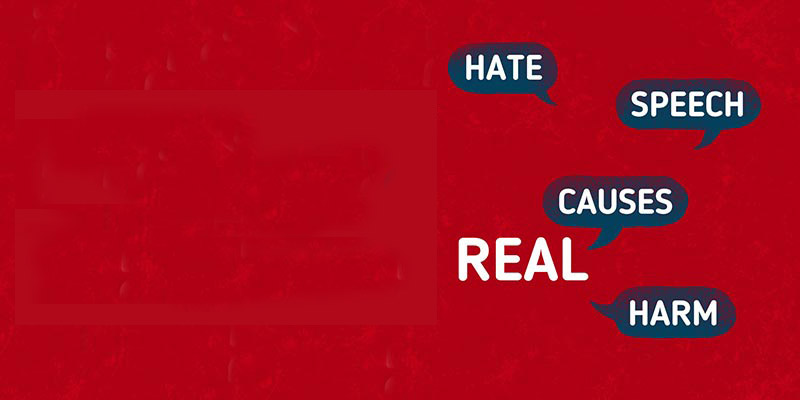- World
- Jun 18
Explainer - UN Strategy and Plan of Action on Hate Speech
• The United Nations observes the International Day for Countering Hate Speech on June 18. It is established by the United Nations General Assembly over concerns about the rising proliferation of the phenomenon worldwide.
• Violence does not start when physical attacks are launched. Violence often starts with words. Words of hatred spread intolerance, divide societies, promote and endorse discrimination and incite violence.
• At the same time, tackling hate speech should never be used to stifle freedom of expression.
• Blanket restrictions, bans and internet shutdowns are not the solution and may violate human rights, including freedom of expression. They may also silence the actors working to stand up against hate speech including civil society, human rights defenders, and journalists.
What is hate speech?
• There is no international legal definition of hate speech. The term hate speech is understood as any kind of communication in speech, writing or behaviour that attacks or uses pejorative or discriminatory language with reference to a person or a group on the basis of who they are, in other words, based on their religion, ethnicity, nationality, race, colour, descent, gender or other identity factor. This generates intolerance and hatred and, in certain contexts, can be demeaning and divisive.
• Hate speech incites violence and undermines social cohesion and tolerance. The devastating effect of hatred is sadly nothing new. However, its scale and impact are nowadays amplified by new technologies of communication, to the point that hate speech has become one of the most frequent methods for spreading divisive rhetoric and ideologies on a global scale and threatening peace.
• Incitement is a very dangerous form of speech, because it explicitly and deliberately aims at triggering discrimination, hostility and violence, which may also lead to or include terrorism or atrocity crimes.
• Hate speech not only affects the specific individuals and groups targeted, but societies at large.
• The escalation from hate speech to violence has played a significant role in the most horrific and tragic crimes of the modern age, from the antisemitism driving the Holocaust, to the 1994 genocide against the Tutsi in Rwanda.
• The world must not trample on freedom of speech and expression, but when that speech is weaponised to violate the rights of others—including inciting atrocity crimes and acts of terrorism, it must not be met with deafening silence that implies apathy or acceptance.
• The Internet and social media have turbocharged hate speech, enabling it to spread like wildfire across borders. The spread of hate speech against minorities during the COVID-19 pandemic provides further evidence that many societies are highly vulnerable to the stigma, discrimination and conspiracies it promotes.
• If left unchecked, hate speech can even harm peace and development, as it lays the ground for conflicts and tensions and wide scale human rights violations.
• Understanding and monitoring hate speech across diverse online communities and platforms is key to shaping new responses. But efforts are often stunted by the sheer scale of the phenomenon, the technological limitations of automated monitoring systems and the lack of transparency of online companies.
UN Strategy and Plan of Action on Hate Speech
• To provide a unified framework for the United Nations to address the issue globally, the UN Strategy and Plan of Action on Hate Speech defines hate speech as ‘any kind of communication in speech, writing or behaviour, that attacks or uses pejorative or discriminatory language with reference to a person or a group on the basis of who they are, in other words, based on their religion, ethnicity, nationality, race, colour, descent, gender or other identity factor”.
• The UN Strategy and Plan of Action provides a system-wide programme with the overriding objective of identifying, preventing and confronting hate speech.
• The Strategy sets out strategic guidance for the United Nations system to address hate speech at the national and global level.
• It aims to give to the UN the room and the resources to address hate speech, which poses a threat to UN principles, values and programmes.
• Measures taken will be in line with international human rights norms and standards, in particular the right to freedom of opinion and expression.
Its objectives are twofold:
i) To enhance United Nations efforts to address root causes and drivers of hate speech.
ii) To enable effective United Nations responses to the impact of hate speech on societies.
The Strategy is grounded on four key principles:
i) The strategy and its implementation to be in line with the right to freedom of opinion and expression. The United Nations supports more speech, not less, as the key means to address hate speech.
ii) Tackling hate speech is the responsibility of all — governments, societies, the private sector, starting with individual women and men. All are responsible, all must act.
iii) In the digital age, the United Nations should support a new generation of digital citizens, empowered to recognise, reject and stand up to hate speech.
iv) We need to know more to act effectively — this calls for coordinated data collection and research, including on the root causes, drivers and conditions conducive to hate speech.
• It also includes ways the UN Secretariat can support the work of the Resident Coordinators in addressing and countering hate speech.
Impact of hate speech on freedom of expression
• Hate speech has always been a live debate in India. Hate speech has not been defined in any law in India. However, legal provisions in certain legislations prohibit select forms of speech as an exception to freedom of speech. Hate speech poses complex challenges to freedom of speech and expression.
• The world must not trample on freedom of speech and expression, but when that speech is weaponised to violate the rights of others — including inciting atrocity crimes and acts of terrorism, it must not be met with deafening silence that implies apathy or acceptance.
• The greater value accorded to the expression, in the scheme of rights, explains the reluctance of the law makers and judiciary in creating exceptions that may curtail the spirit of this freedom. Perhaps, this is the reason behind the reluctance in defining hate speech.
• Right to freedom of speech and expression is one of the most essential liberties recognised by the democratic States. The objective of free speech in a democracy is to promote plurality of opinions.
• Hate speech is an expression which is likely to cause distress or offend other individuals on the basis of their association with a particular group or incite hostility towards them.
• The issue of hate speech has assumed greater significance in the era of the Internet, since the accessibility of the internet allows offensive speeches to affect a larger audience in a short span of time.
• The Supreme Court of India had differentiated between three forms of speech, discussion, advocacy and incitement. It was held by the Court that a speech can only be limited on grounds of exceptions mentioned in Article 19(2) when it reaches the threshold of incitement. All other forms of speech, even if offensive or unpopular, have to be protected under Article 19(1)(a). Incitement is the key to determining the constitutionality of restriction on free speech.
• Liberty and equality are complementary and not antithetical to each other. The intent of freedom of speech is not to disregard the weaker sections of the society but to give them equal voice.
• Similarly, the intent of equality is not to suppress this liberty but to balance it with the necessities of a multicultural and plural world, provided such constraint does not unduly infringe on the freedom of expression.
• Thus, incitement to not only violence but also to discrimination has been recognised as a ground for interfering with freedom of expression.
Manorama Yearbook app is now available on Google Play Store and iOS App Store


